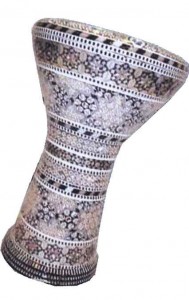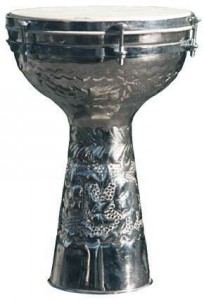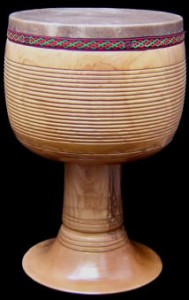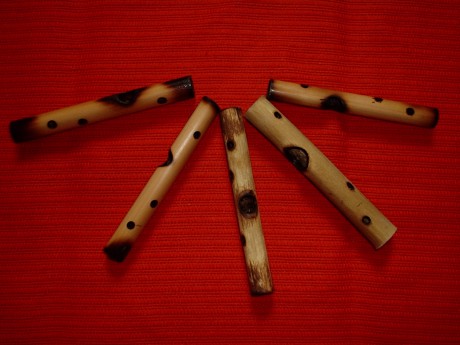Tombak - Dumbek - Zarb


Tradiční hudební nástroje středního východu
Ney - orientální rákosová či bambusová podélná
flétna různé délky (do cca 60cm), s 6 předními a 1 zadním
otvorem. Pochází ze starověkého Egypta, je rozšířená po
celém středním východě a patří k základním nástrojům
persko-arabské hudební tradice.
Out - tradiční arabská loutna
Tanbura - dlouhokrká loutna
Kanun - turecká mnohostrunná citera (75 strun)
Kemenče - malé housle, hraje se na ně jak na violocelo
| Některé typické nástroje tradiční hudby středního Východu : | ||
| Tár Kemenče Rabab |
 |
Ney - flétny různé délky Kanun |
| O u t Tombak |
Daf - velký plochý perský rámový buben, používaný často při dervišských obřadech Zikr
Mazhar - jednoblaný bubínek
Kudim - malé tympány
Halile - činely
Dutár - středoasijská dvoustrunná loutna
Gidžak, Satú - smyčcové nástroje
Tár - dlouhokrká loutna rozšířená v Íránu, Azerbajdžánu i Arménii
Rabab - tradiční persko-afgánská loutna s 5 hlavními strunami a 13 sympatetickými, má posunovatelné pražce. Loutna pro zvonivé drnkání typické v arabské hudbě.
Z rababu se vyvinul indický Sarod.
Goblet drum
From Wikipedia, the free encyclopedia
The goblet drum (also chalice drum) is a goblet shaped hand drum used in Arabic, Assyrian, Persian, Balkan, Armenian, Azeri and Turkish music. Its thin, responsive drumhead and resonance help it produce a distinctively crisp sound. It is of ancient origin, and is believed by some to have been invented before the chair.

Contents[hide] |
[edit] It has many names, according to the location:
- Darbakeh/Tarabuka (General)
- Toumberleki/Toumpeleki (Greece)
- Tumbuluchiu (Romania)
- Darbuk (Yugoslavia)
- Tarambuke (Balkans)
- Dobouk (Hungary)
- Doumbek/Doumbeg (Armenia)
- Darbuka/Dumbelek (Israel Turkey)
- Dumbul/Dunbul (Azerbaijan)
- Tablah/Tableh (General)(Arab)
- Derbakeh (Lebanon)
- Dombuk/Derbakeh (Assyria)
- Tepill (Kurdistan)
- Tombak/Tonbak/Zarb (Iran)
- Tarbouka (Bukhori)
- Zairbaghali (Afganistan (Dari)
- Klong (or Glong)Yao (Laos Thailand)
[edit] Technique
Goblet drums are played with a much lighter touch and quite different strokes (sometimes including rolls or quick rhythms articulated with the fingertips) than hand drums such as the djembe, found in Africa.
There are two main types of goblet drums. The Egyptian style has rounded edges around the head, whereas the Turkish style exposes the edge of the head. The exposed edge allows closer access to the head so finger-snapping techniques can be done, but the hard edge discourages the rapid rolls possible with the Egyptian style.
The goblet drum may be played while held under one arm or by placing it between the knees while seated. It produces a resonant, low-sustain sound while played lightly with the fingertips and palm. Some players move their fists in and out of the bell to alter the tone. There are a variety of rhythms that form the basis of the folkloric and modern music and dance styles of the Middle East.
There are two main sounds produced by the goblet drum. The first is called the 'doum'. It is the deeper bass sound produced by striking the head near the center with the length of the fingers and palm. The second is called the 'tek' and is the higher-pitched sound produced by hitting near the edge of the head with the fingertips. A 'tek' struck with the secondary hand is also known as a 'ka'. Additionally, there are more complex techniques including snaps, slaps, pops and rolls that are used to ornament the basic rhythm. Hand clapping and hitting the sides of the drum can be used in addition to drumhead sounds.
Another technique commonly used in Bulgaria, Turkey, and Egypt, and is to tap with the fingers of one hand and with a thin stick in the other. In Turkey the stick is called the çubuk, which means wand, or stick. The Gypsies of most of the countries associated with the goblet drum use this technique.
[edit] Notable goblet drum players
- Sohail Rahmany - London Based Afghan Tombak player; the best currently living in the United Kingdom.
- Guy Schalom - UK Arabic Percussionist. See www.guyschalom.com
- Ruben van Rompaey - Dutch darbuka player. See: darbuka.nl.
- Burhan Öçal - Turkish player fusing Roma-Balkan music with jazz, Turkish classical music, and even electronic music.
- Mısırlı Ahmet - Turkish Darbuka player (studied in Egypt and fused Turkish and Arabic technique); invented and popularized modern "split-finger" playing technique. In Turkish, Mısırlı means "the Egyptian". In Egypt he is called "Ahmet the Turk".
- Ovidiu Lipan - Romanian player, drummer of the band Phoenix
- Levant Yıldırım - Younger brother of Misirli Ahmet; another virtuoso.
- Haviv Shmuel - Israeli professional darbuka player
- Halim El-Dabh - Egyptian-born ethnomusicologist
- Issam Houshan - Syrian player/teacher/composer recently featured in Bellydance Superstars
- Souhail Kaspar - Lebanese; influential teacher of traditional music and technique in the United States and abroad since 1970s
- Hani Naser
- Hossam Ramzy - Egyptian-born traditional and jazz drummer; successful in integrating traditional hand-drumming into (western) pop music
- Setrak Sarkissian - Lebanese player featured on many of the "classic" bellydance recordings from the 1970s; simplistic technique but wonderful feel.
- Hossein Tehrani - possibly the most famous Persian tonbak player
- Suat Borozan/Berkay - Istanbul based professional Darbuka player; highly skilled.
- Pejman Haddadi - L.A. Based Persian Tombak player; the best currently living in the United States.
- Daveed Korup - Darbuka player and designer, performing throughout the world
- Buddy Sarkissian - Armenian-American dumbeg player, founder of the Kef Time Band
- Said El Artist - Alexandrian- born Egyptian Tabla/Darbuka star of the Arabic world since the 1970s; his brightly ornamented playing has greatly influenced Egyptian style and helped to elevate the public reception of traditional percussion from folk to high art.
- Seido Salifoski - Macedonian Roma darabuka virtuoso, based in New York, experienced in Balkan, Turkish, Greek and Middle Eastern Percussion with flare of jazz. Also founder of Romski Boji.
- Raquy - American Dumbek/darbukah/tabla virtuoso; Her compositions incorporate Turkish, Persian, and Egyptian structures; a notable teacher
- Tobias Roberson - American percussionist Tobias Roberson is a virtuoso specializing in Middle Eastern and Balkan music.
- Elitsa Todorova - Bulgarian female folklore musician.
- Stoyan Yankoulov - Bulgarian percussionist.
- Bill Koutsouros - Greek American Tsoumbeliki/Doumbek/Darbukah/Tabli virtuoso whose percussion compositions incorporate Greek, Turkish, Lebanese, Egyptian and original world fusion forms; a prominent composer, teacher and performer based in the Philadelphia, PA area.
- Joseph Tayoun - Lebanese American Mid-Eastern percussion virtuoso; a highly skilled musician and teacher based in Collingswood, NJ.
[edit] External links
- Egyptian gawharet el fan mother of pearl drums gallery
- Egyptian drums ultimate gallery
- Nay-Nava the encyclopedia of persian music instruments
- Jas's Middle Eastern Rhythms FAQ
- The Quick and Dirty Guide to the Doumbek
- The Doumbek Page
- Tombak Network
- Website of Uncle Mafufo - Drum Instruction
- Worldepot - Unique Custom Darbuka Doumbek Drums
- http://www.framedrums.de - Online Lessons, Videos and Sounds
- Goblet drums and tombak through history
- Organology of tubular and goblet drums


